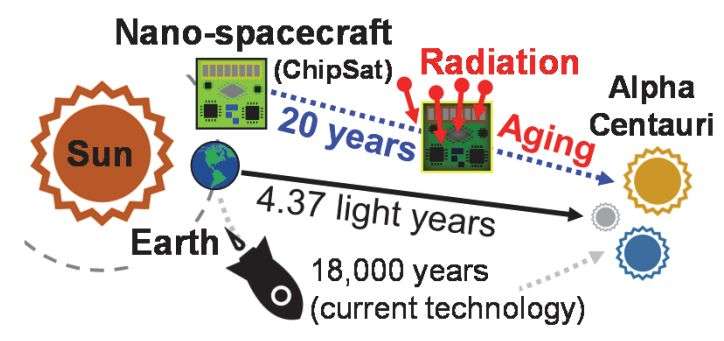A nano-spacecraft such as ChipSat, which consists of solar cells and functional blocks in a printed circuit board, would face a high risk of damage from radiation and aging issues on a flight into deep space. Especially, most of functional blocks such as microcontroller, memories, sensors, and communication system are semiconductor-based chips. Credit: D.-I. Moon et al.
(TechXplore)—Self healing chips—healing after radiation damage—could have an impact on interstellar spacecraft, according to reports. The news involves scientists at NASA and the Korean Institute of Science and Technology (KAIST); they have been developing new technologies in the interstellar realm.
The breakthrough was announced earlier this week during the International Electron Devices Meeting in San Francisco.
IEEE Spectrum said that in working with KAIST, NASA was pioneering development of "tiny spacecraft made from a single silicon chip that could slash interstellar exploration times."
Inverse described this breakthrough as "a transistor for silicon chips that can heal itself after radiation damage."
Neel Patel in Inverse referred to ambitions "to create chip-sized spacecraft that could be shot off into space at ultra-high speeds and reach neighboring star systems within a generation's time."
Patel said that out of five interstellar probes (Voyager 1, Voyager 2, Pioneer 10, Pioneer 11, and New Horizons), only Voyager 1 made it to interstellar space.
Making it is not easy. Patel wrote how "deep space is riddled with intense bouts of radiation emanating from other stars and planets, as well as rapid swings in temperature." Interestingly, in their work, an extra gate "repairs transistors through heating."
IEEE Spectrum: For an ordinary silicon chip, 20 years in space is too long, bombarded by radiation of very high energy. The report also said the researchers' idea involved letting the devices suffer damage but then adding an extra contact to the transistors—using this contact to heal the devices with heating.
Patel said, "the research team points to experiments that show radiation-damaged flash memory can be recovered up to 10,000 times over through heating, and DRAM can be recovered almost a trillion times. This is critical for an interstellar mission that could span for several decades."
Their research is discussed in the paper, "Sustainable Electronics for Nano-Spacecraft in Deep Space Missions."
The authors are from the Center for Nanotechnology, NASA Ames Research Center, and School of Electrical Engineering, KAIST, Korea. "An on-the-fly self-healing device is experimentally demonstrated for sustainability of space electronics. A high temperature generated by Joule heating in a gate electrode provides on-chip annealing of damages induced by ionizing radiation, hot carrier, and tunneling stress."
Contributing Editor Richard Stevenson, IEEE Spectrum, said, "If a silicon chip were used as a spacecraft, calculations suggest that it could travel at one-fifth of the speed of light and reach the nearest stars in just 20 years. That's one hundred times faster than a conventional spacecraft can offer."
More information: — Sustainable Electronics for Nano-Spacecraft in Deep Space Missions [PDF]
— Session 31: Characterization, Reliability and Yield Reliability Modeling and Characterization of Dielectrics and Interfaces: ieee-iedm.org/session-31-chara … lectrics-interfaces/
© 2016 TechXplore























